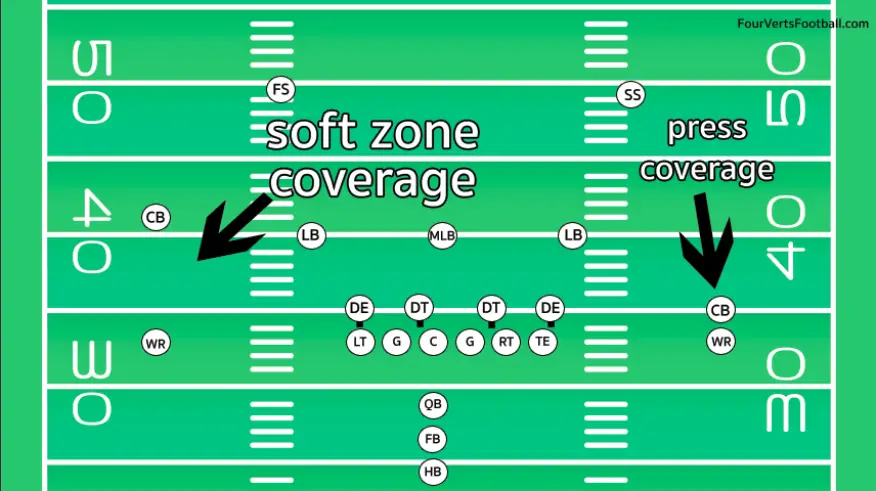Soft zone coverage in football occurs when defensive backs are playing more than seven yards off the line of scrimmage. This is a more conservative style of pass coverage and makes it more difficult for the offense to complete long passes.
The opposite of soft coverage is press coverage. Press coverage involves defensive backs starting the play with little to no space between themselves and the receiver.
In soft zone coverage, defensive backs will have a large cushion which makes it difficult for the receiver to get behind them.
Other coverage styles like soft zone coverage include bump and run coverage or banjo pass coverage.
Benefits and detriments of soft zone coverage
Now that you know what soft zone coverage is in football it is time to break down the pros and cons of using this coverage.
No big plays
The main benefit and purpose of playing soft zone coverage in football is to discourage big plays from happening.
By playing this style of defense there will be more players deeper into the defensive backfield. These players will be able to cover receivers and break up passes that come deep down the field.
Starting further back from the line of scrimmage makes it much more difficult for the wide receivers to get behind the defensive backs.
Oftentimes teams will use this style of defense when they have a large lead. This way they will not allow long passes to be completed.
This makes it more difficult for the other team to complete their come back.
Keeping their eyes on the quarterback
Another benefit of using soft zone coverage in football is that your defensive backs are going to be able to keep an eye on the quarterback.
When playing press coverage these players will often run alongside the receiver with the back turned to the quarterback making it more difficult to anticipate when a throw is coming.
Having your eyes on the quarterback may allow a defender to read the quarterback’s eyes and undercut a receiver’s route.
Susceptible to quick passes
One detriment to the soft zone coverage defense is that it has a weakness in defending quick passes.
In this defense, the defensive backs are going to be seven or more yards off the line of scrimmage.
This means if the quarterback quickly passes the ball to a receiver he will have plenty of open space in front of him in order to pick up some yards.
This can be especially effective on screen passes in which a receiver may catch the ball and have several blockers in front of him while the defenders are still a few yards downfield.
When playing press coverage these sorts of quick passes are not able to be completed as the defensive back will already be in a position to break up the pass.
No contact at the line of scrimmage
Another negative aspect of playing a soft zone coverage is that the defensive backs are not able to contact the wide receivers.
In football, it is legal for the cornerback to contact a wide receiver within the first five yards of the line of scrimmage. This contact can make it difficult for the receiver to start his route.
If a cornerback is able to get quality contact on a wide receiver it can often throw off the timing of the route making it less likely he will get the ball.
That is all on soft zone coverage in football see our guides on the cover 2 defense or learn what triple coverage is.

